2014 SUBARU TRIBECA warning
[x] Cancel search: warningPage 27 of 426
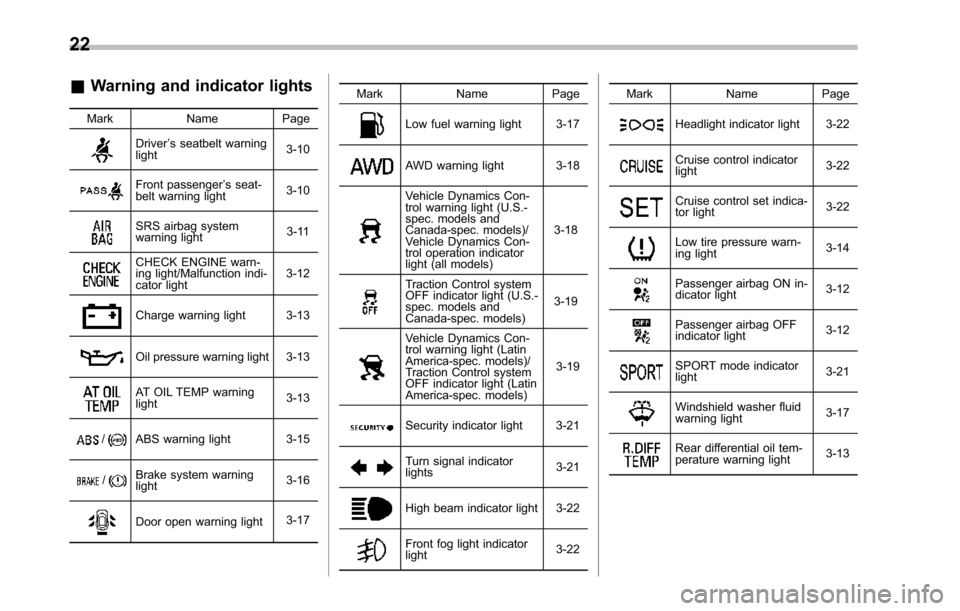
22
&Warning and indicator lights
Mark Name Page
Driver’s seatbelt warninglight3-10
Front passenger’s seat-belt warning light3-10
SRS airbag systemwarning light3-11
CHECK ENGINE warn-ing light/Malfunction indi-cator light3-12
Charge warning light 3-13
Oil pressure warning light3-13
AT OIL TEMP warninglight3-13
/ABS warning light 3-15
/Brake system warninglight3-16
Door open warning light3-17
Mark Name Page
Low fuel warning light 3-17
AWD warning light 3-18
Vehicle Dynamics Con-trol warning light (U.S.-spec. models andCanada-spec. models)/Vehicle Dynamics Con-trol operation indicatorlight (all models)
3-18
Traction Control systemOFF indicatorlight (U.S.-spec. models andCanada-spec. models)
3-19
Vehicle Dynamics Con-trol warning light (LatinAmerica-spec. models)/Traction Control systemOFF indicator light (LatinAmerica-spec. models)
3-19
Security indicator light 3-21
Turn signal indicatorlights3-21
High beam indicator light3-22
Front fog light indicatorlight3-22
Mark Name Page
Headlight indicator light 3-22
Cruise control indicatorlight3-22
Cruise control set indica-tor light3-22
Low tire pressure warn-ing light3-14
Passengerairbag ON in-dicator light3-12
Passenger airbag OFFindicator light3-12
SPORT mode indicatorlight3-21
Windshield washer fluidwarning light3-17
Rear differential oil tem-perature warning light3-13
Page 29 of 426

24
Function settings
A SUBARU dealer can change the settings of the functions shown in the following table to meet your personal requirements. Contactthe nearest SUBARU dealer for details. If your vehicle is equipped with the genuine SUBARU navigation system, the settings for someof these functions can be changed using the navigation monitor. For details, please refer to the Owner’s Manual supplement for thenavigation system.
Item Function Possible settings Default setting Page
Alarm system Alarm system Operation/Non-operation Operation 2-16
Monitoring start delay time (after closure of doors) 0 second/30 seconds 30 seconds 2-17
Impact sensor operation (only models with shocksensors (dealer option))Operation/Non-operation Non-operation 2-20
Passive arming Operation/Non-operation Non-operation 2-19
Dome light/map lights illuminationON/OFFOFF 2-16
Remote keyless entry sys-temHazard warning flasher Operation/Non-operation Operation 2-8
Audible signal Operation/Non-operation Operation 2-11
Key lock-in prevention Key lock-in preventionOperation/Non-operationOperation2-7
Remote engine start system(dealer option)Horn chirp confirmation ON/OFF ON 7-10
Rear window defogger Rear window defoggerOperation for 15 minutes/Continuous operationOperation for 15 minutes 3-37
Windshield wiper deicer Windshield wiper deicer Operation for 15 minutes/Continuous operationOperation for 15 minutes 3-36
Map lights/Dome light Operation of map lights/dome light OFF delaytimerOFF/Short/Normal/Long Normal 6-2/6-3
Map lights Illumination in conjunction with a door open Operation/Non-operation Operation(Illumination - ON)6-3
Battery drainage preventionfunctionBattery drainage prevention function Operation/Non-operation Operation 2-6
Page 30 of 426
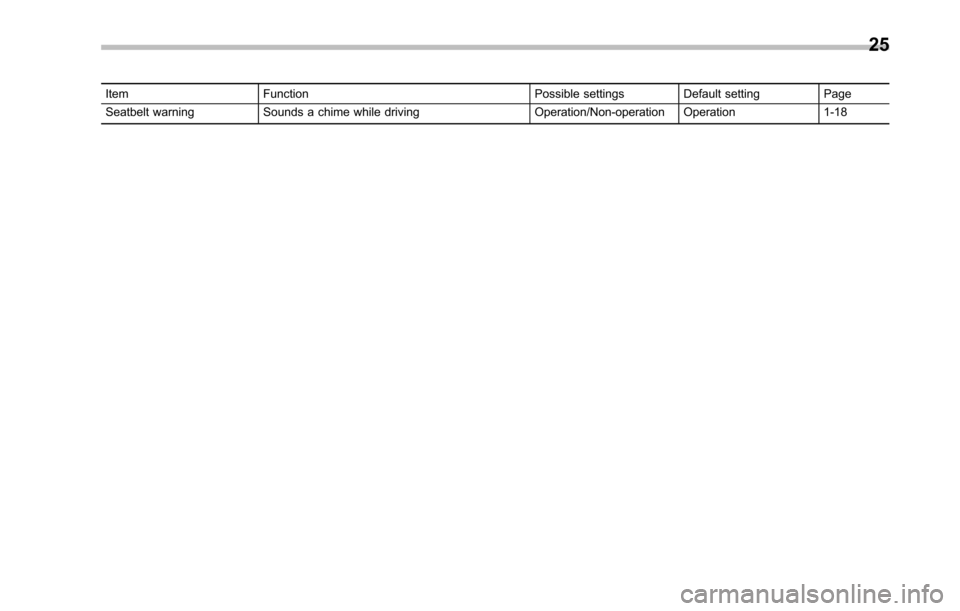
Item Function Possible settings Default setting Page
Seatbelt warning Sounds a chime while driving Operation/Non-operation Operation 1-18
25
Page 32 of 426
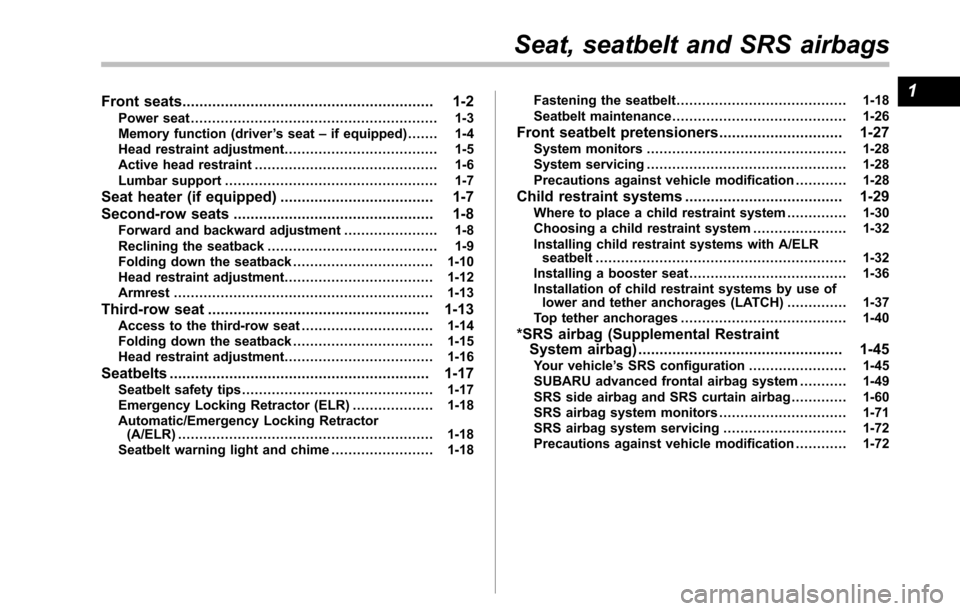
Front seats........................................................... 1-2Power seat.......................................................... 1-3Memory function (driver’s seat–if equipped)....... 1-4Head restraint adjustment.................................... 1-5Active head restraint........................................... 1-6Lumbar support.................................................. 1-7
Seat heater (if equipped).................................... 1-7
Second-row seats............................................... 1-8Forward andbackward adjustment...................... 1-8Reclining the seatback........................................ 1-9Folding down the seatback................................. 1-10Head restraint adjustment................................... 1-12Armrest............................................................. 1-13
Third-row seat.................................................... 1-13Access to the third-row seat............................... 1-14Folding down the seatback................................. 1-15Head restraint adjustment................................... 1-16
Seatbelts............................................................. 1-17Seatbelt safety tips............................................. 1-17Emergency Locking Retractor (ELR)................... 1-18Automatic/Emergency Locking Retractor(A/ELR)............................................................ 1-18Seatbelt warning light and chime........................ 1-18
Fastening the seatbelt........................................ 1-18Seatbelt maintenance......................................... 1-26
Front seatbelt pretensioners............................. 1-27System monitors............................................... 1-28System servicing............................................... 1-28Precautions against vehicle modification............ 1-28
Child restraint systems..................................... 1-29Where to place a child restraint system.............. 1-30Choosing a child restraint system...................... 1-32Installing child restraint systems with A/ELRseatbelt........................................................... 1-32Installing a booster seat..................................... 1-36Installation of child restraint systems by use oflower and tether anchorages (LATCH).............. 1-37Top tether anchorages....................................... 1-40
*SRS airbag (Supplemental RestraintSystem airbag)................................................ 1-45Your vehicle’s SRS configuration....................... 1-45SUBARU advanced frontal airbag system........... 1-49SRS side airbagand SRS curtain airbag............. 1-60SRS airbag system monitors.............................. 1-71SRS airbag system servicing ............................. 1-72Precautions against vehicle modification............ 1-72
Seat, seatbelt and SRS airbags
1
Page 33 of 426
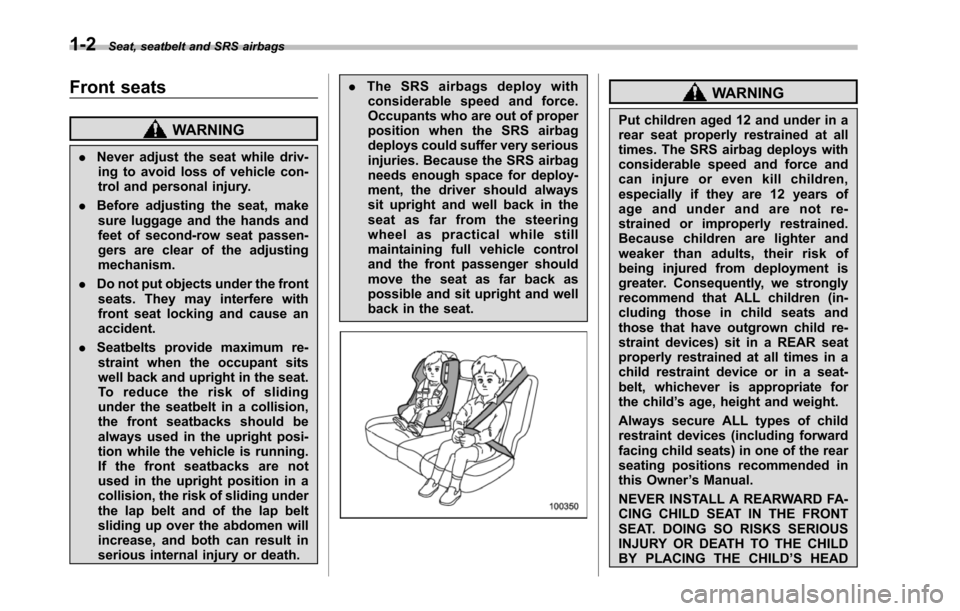
1-2Seat, seatbelt and SRS airbags
Front seats
WARNING
.Never adjust the seat while driv-ing to avoid loss of vehicle con-trol and personal injury.
.Before adjustingthe seat, makesure luggage and the hands andfeet of second-row seat passen-gers are clear of the adjustingmechanism.
.Do not put objects under the frontseats. They may interfere withfront seat locking and cause anaccident.
.Seatbelts provide maximum re-straint when the occupant sitswell back and upright in the seat.To r e d u c e t h e r i s k o f s l i d i n gunder the seatbelt in a collision,the front seatbacks should bealways used in the upright posi-tion while the vehicle is running.If the front seatbacks are notused in the upright position in acollision, the risk of sliding underthe lap belt and of the lap beltsliding up over the abdomen willincrease, and both can result inserious internalinjury or death.
.The SRS airbags deploy withconsiderable speed and force.Occupants who are out of properposition when the SRS airbagdeploys could suffer very seriousinjuries. Because the SRS airbagneeds enough space for deploy-ment, the driver should alwayssit upright and well back in theseat as far from the steeringwheel as practical while stillmaintaining full vehicle controland the frontpassenger shouldmove the seat as far back aspossible and sit upright and wellback in the seat.
WARNING
Put children aged 12 and under in arear seat properly restrained at alltimes. The SRS airbag deploys withconsiderable speed and force andcan injure or even kill children,especially if they are 12 years ofage and under and are not re-strained or improperly restrained.Because children are lighter andweaker than adults, their risk ofbeing injured from deployment isgreater. Consequently, we stronglyrecommend that ALL children (in-cluding those in child seats andthose that have outgrown child re-straint devices) sit in a REAR seatproperly restrained at all times in achild restraint device or in a seat-belt, whichever is appropriate forthe child’s age, height and weight.
Always secure ALL types of childrestraint devices (including forwardfacingchild seats) in one of the rearseating positions recommended inthis Owner’s Manual.
NEVER INSTALL A REARWARD FA-CING CHILD SEAT IN THE FRONTSEAT. DOING SO RISKS SERIOUSINJURY OR DEATH TO THE CHILDBY PLACING THE CHILD’S HEAD
Page 34 of 426
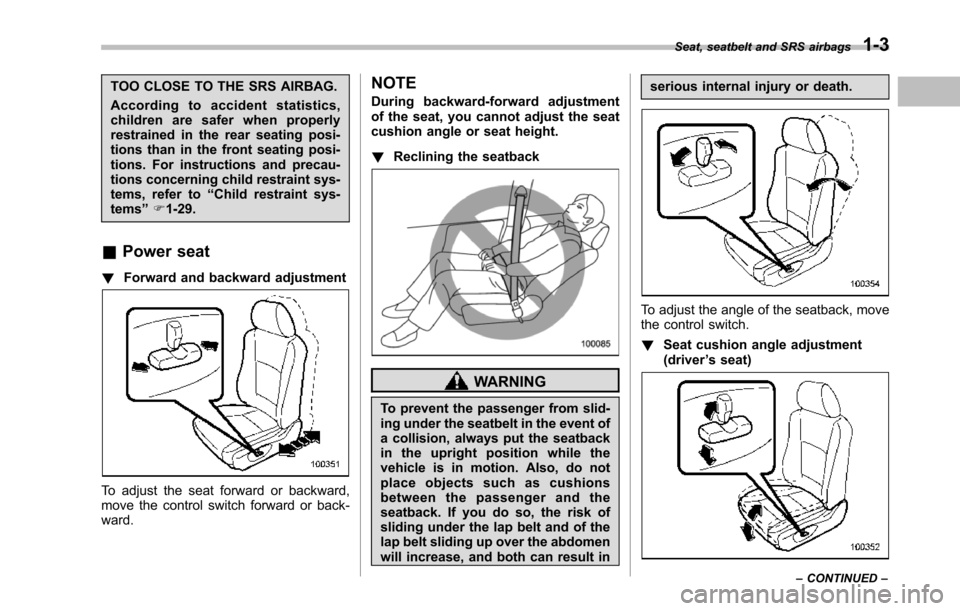
TOO CLOSE TO THE SRS AIRBAG.
According to accident statistics,children are safer when properlyrestrained in the rear seating posi-tions than in the front seating posi-tions. For instructions and precau-tions concerning child restraint sys-tems, refer to“Child restraint sys-tems”F1-29.
&Power seat
!Forward and backward adjustment
To adjust the seat forward or backward,move the control switch forward or back-ward.
NOTE
During backward-forward adjustmentof the seat, you cannot adjust the seatcushion angle or seat height.
!Reclining the seatback
WARNING
To prevent the passenger from slid-ing under the seatbelt in the event ofa collision, always put the seatbackin the upright position while thevehicle is in motion. Also, do notplace objects such as cushionsbetween the passenger and theseatback.If you do so, the risk ofsliding under the lap belt and of thelap belt sliding up over the abdomenwill increase, and both can result in
serious internal injury or death.
To adjust the angle of the seatback, movethe control switch.
!Seat cushion angle adjustment(driver’s seat)
Seat, seatbelt and SRS airbags1-3
–CONTINUED–
Page 35 of 426
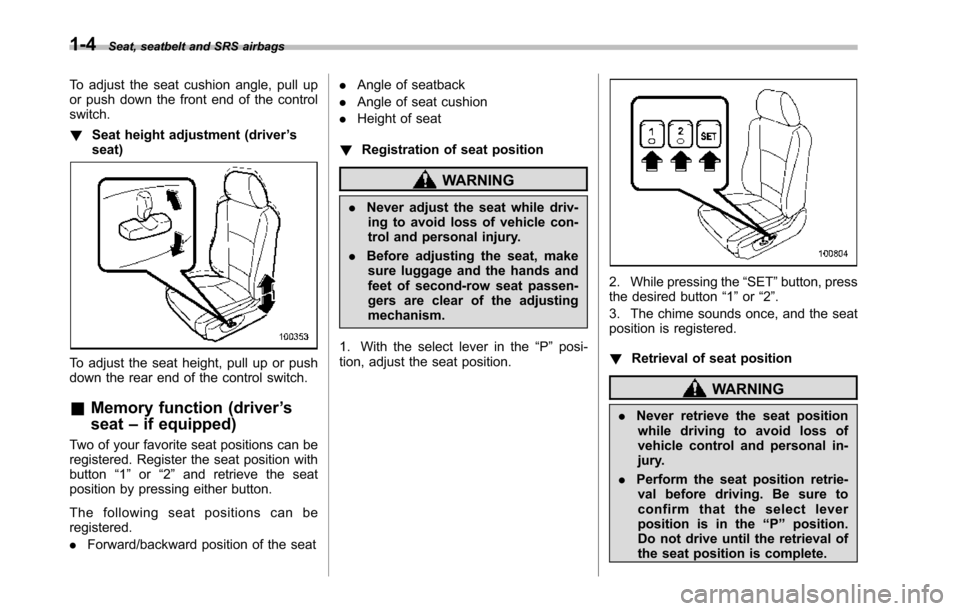
1-4Seat, seatbelt and SRS airbags
To adjust the seat cushion angle, pull upor push down the front end of the controlswitch.
!Seat height adjustment (driver’sseat)
To adjust the seat height, pull up or pushdown the rear end of the control switch.
&Memory function (driver’s
seat–if equipped)
Two of your favorite seat positions can beregistered. Register the seat position withbutton“1”or“2”and retrieve the seatposition by pressing either button.
The following seat positions can beregistered.
.Forward/backward position of the seat
.Angle of seatback
.Angle of seat cushion
.Height of seat
!Registration of seat position
WARNING
.Never adjust the seat while driv-ing to avoid loss of vehicle con-troland personal injury.
.Before adjusting the seat, makesure luggage and the hands andfeet of second-row seat passen-gers are clear of the adjustingmechanism.
1. With the select lever in the“P”posi-tion, adjust the seat position.
2. While pressing the“SET”button, pressthe desired button“1”or“2”.
3. The chime sounds once, and the seatposition is registered.
!Retrieval of seat position
WARNING
.Never retrieve the seat positionwhile driving to avoid loss ofvehicle control and personal in-jury.
.Perform the seat position retrie-val before driving. Be sure toconfirm that the select leverposition is in the“P”position.Do not drive until the retrieval ofthe seat position is complete.
Page 37 of 426
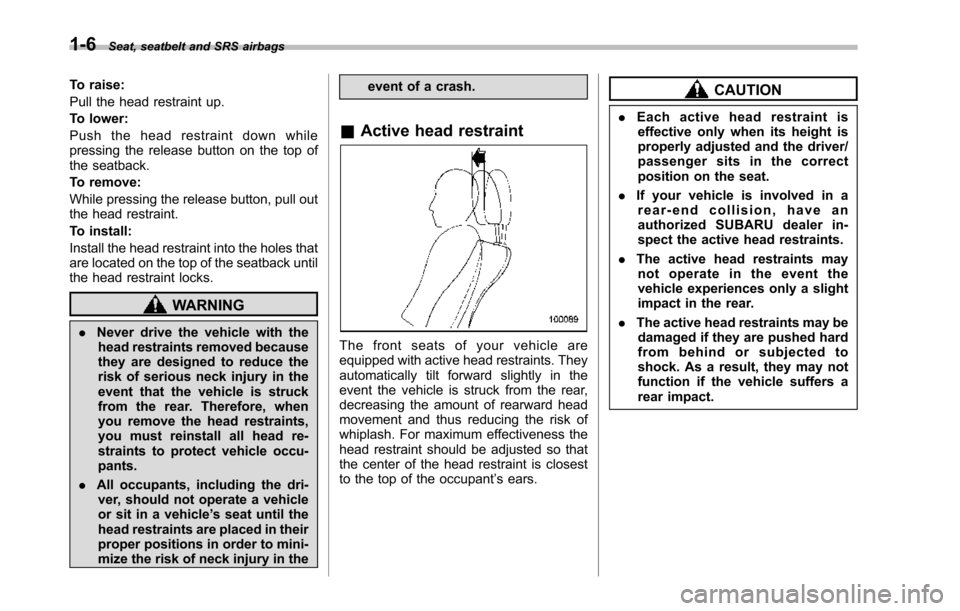
1-6Seat, seatbelt and SRS airbags
To raise:
Pull the head restraint up.
To lower:
Push the head restraint down whilepressing the release button on the top ofthe seatback.
To remove:
While pressing the release button, pull outthe head restraint.
To install:
Install the head restraint into the holes thatare located on the top of the seatback untilthehead restraint locks.
WARNING
.Never drive the vehicle with thehead restraints removed becausethey are designed to reduce therisk of serious neck injury in theevent that the vehicle is struckfrom the rear. Therefore, whenyou remove the head restraints,youmust reinstall all head re-straints to protect vehicle occu-pants.
.All occupants, including the dri-ver, should not operate a vehicleor sit in a vehicle’s seat until thehead restraints are placed in theirproper positions in order to mini-mize the risk of neck injury in the
event of a crash.
&Active head restraint
The front seats of your vehicle areequipped with active head restraints. Theyautomaticallytilt forward slightly in theevent the vehicle is struck from the rear,decreasing the amount of rearward headmovement and thus reducing the risk ofwhiplash. For maximum effectiveness thehead restraintshould be adjusted so thatthe center of the head restraint is closestto the top of the occupant’s ears.
CAUTION
.Each active head restraint iseffective only when its height isproperly adjusted and the driver/passenger sits in the correctposition on the seat.
.If your vehicle is involved in arear-end collision, have anauthorized SUBARU dealer in-spect the active head restraints.
.The active head restraints maynot operate in the event thevehicle experiences only a slightimpact in the rear.
.The activehead restraints may bedamaged if they are pushed hardfrom behind or subjected toshock. As a result, they may notfunction if the vehicle suffers arear impact.